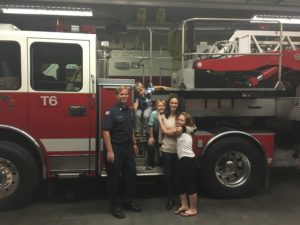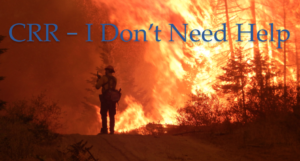The Fire Service Can’t do Community Risk Reduction by Ourselves
Photo Credit – https://commons.wikimedia.org/wiki/File:Firefighter_at_Cougar_Creek_Fire_(20876410259).jpg
The fire service does many things by themselves. Community Risk Reduction should not be one of them. The first word, “Community”, should let us know this. Without Community Risk Reduction Partnerships, our greatest efforts in Community Risk Reduction will fall short. There are many existing organizations that can and will push our CRR programs much farther than if we attempt to do them on our own.
What types of organizations should we look for to collaborate on Community Risk Reduction? The following is a good start; Law Enforcement, other government agencies, religious institutions, service groups/clubs, scouts, private industry, educational institutions (all levels), for profit and non profit organizations. Any service organization is a possible partner.
The Fire Service Can’t be Everything to Everyone
When looking for assistance, keep a very wide view. Some organizations can help the community itself, while others can help you. We can’t be everything to everyone, even though sometimes we try. As an example, we usually aren’t very good at long term solutions for medical patients. We get in and out, deal with the emergency at hand and move on to the next call. Are there organizations we can refer these chronic or long term patients to other than the ER?
Here are a couple of recent examples where the fire service teamed up with groups to further their missions.
Riverside, CA Fire and Police Engagement of STEM Students for CRR
We are very proud of our home town, Riverside, CA, public safety officials for engaging high school students to assist with Community Risk Reduction. The idea is brilliant. Engage STEM (Science, Technology, Engineering, & Math) high school students to come up with solutions to overcome current problems. The passion that these students bring can be powerful. It may even set these students up for future careers and passions. This should be an example emulated throughout the public safety sector.
Poudre Fire Authority Utilizes Film Students to Further CRR Efforts
How many of us have film and photography clubs or classes in our community? Probably everyone of us. Look no further than your local high school or college. Let them help you make PSA’s, videos, and a host of other things to engage your community. How often do we try to teach ourselves how to edit video when we could have utilized other resources for free. These students are learning a potential career as well as learning about fire safety.
Do you need fire safety materials? Of course we can utilize Vision 20/20 but there may be something specific to your community you want to cover. Again, educational facilities can fill this void. What is our relationship with our local educational facilities? Let’s reach out to them to see what they can do for us.
Look for opportunities to do Virtual Community Risk Reduction. These are opportunities to connect with your community without human contact through teaching surveys, videos, and online or printed information. Its not that we don’t want human contact, but we have limited resources. Use those resources for the things that need that human contact. Virtual Community Risk Reduction efforts are typically much cheaper than hiring staff and allow you to focus your efforts.
“Community” Based Community Risk Reduction
Community Risk Reduction is so much more that Fire Prevention. Departments that simply change the name of Fire Prevention to Community Risk Reduction without changing their programs and processes are falling short. Look to your community. What are its true needs? Then look for other partners in your community to help you fill those needs. They are out there doing great things, just like you are.
 Brent Faulkner is a founding member of MBIntel and now serves as its CEO. He has 20 years of experience in the fire service. During this time, he has responded to numerous emergency situations including structure fires, wildland fires, hazardous materials responses, emergency medical situations, and numerous types of rescues. In addition, he has served on a Type 1 Hazardous Materials Response Team for 14 years.
Brent Faulkner is a founding member of MBIntel and now serves as its CEO. He has 20 years of experience in the fire service. During this time, he has responded to numerous emergency situations including structure fires, wildland fires, hazardous materials responses, emergency medical situations, and numerous types of rescues. In addition, he has served on a Type 1 Hazardous Materials Response Team for 14 years.
Brent had a defining moment in his career which, as a result, lead him to MBIntel. He lead a team in critical infrastructure protection at a recognized Department of Homeland Security (DHS) Terrorism Fusion Center. This team was responsible for increasing the safety of critical infrastructure as it relates to terrorism, general security, and natural disasters. He also specializes in emergency preparedness for homeowners and businesses. He has a master’s degree in management, a bachelor’s degree in occupational studies, an associate’s degree in hazardous materials response, and another in fire science.

